
 |
||||||||
|
|
||||||||
The Guards of I.33 and Their Footwork and CutsBy
Randall Pleasant
|
|
1st vs. Half-Shield
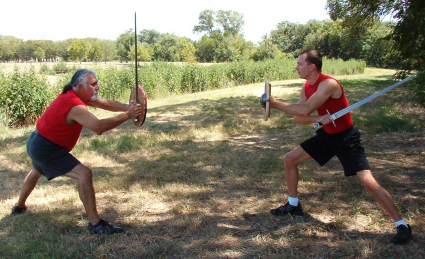 |
1st vs. Krucke
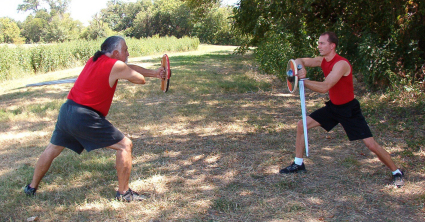 |
Second Guard - Right Shoulder (humero dextrali)
Second Guard is held with the sword at the right shoulder with the blade pointing backwards. Second guard is an equivalent to the longsword guard Vom Tag. The left foot is always forward. Both the Closed and Open Stances are used with Second guard. The Open Stance is clearly seen with Second guard in the Byzantine art presented by Dawson (2009:82). A passing step with either leg will result in a transition into the Fourth Guard (Head). In transitioning from the Second guard to Fourth guards, the right hand will naturally move from the right shoulder to over the head.
The most natural cut from the Second guard is a true edge diagonal cut (right Zorn). However, this cut is never shown in I.33. The primary attack from Second guard in I.33 is a descending false edge cut (Schiller). I.33 does show a vertical true edge cut from Second guard, but only as an attempt to separate the adversary's sword and shield. The reason a right true edge diagonal cut is not shown in I.33 is because Second guard is countered by the Cover, which is very effective at over binding against a right diagonal cut, setting the cutter up for a Shield-Strike. Therefore, I.33 teaches how to break the Cover from Second guard with a false edge, which establishes a much more effective bind, leaving the cutter in an almost mirror position to the Cover. In short, a right diagonal true edge cut is powerful and the sword hand is well protected, but tactically the cut is less effective than a false edge cut.
The Stepping Through (durchtreten) technique shown on page 18 [9V] (Forgeng 2003:54) has been mistakenly interpreted by Brian Hunt (2007) and others I.33 scholars as showing a true edge vertical cut to the hands or arms. In actuality, Stepping Through is nothing more than a Duplieren action performed just as it is with a longsword (see Meyer 1.19r.3 in Forgeng 2006:64]), thus the cut is actually horizontal. The Stepping Through described on page 4 [2V] (Forgeng 2003:27) is just the same Duplieren action on the left.
|
2nd vs. Cover
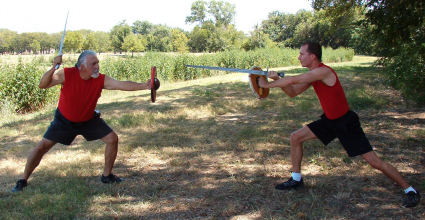 |
2nd vs. Cover
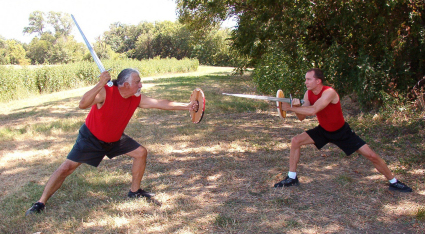 |
Third Guard - Left Shoulder (humero sinistro)
In Third Guard the sword is held over the left shoulder with the blade pointing back. The right leg is forward and the left leg is to the rear. Both the Closed and Open Stances can be used while in Third guard. A transition to the Fourth guard can be made by simply raising the sword over the head.
The natural cut from Third guard is a left true edge diagonal cut. This cut is quick and powerful but because the blade is cutting over the buckler the sword hand is exposed during the cut. However, this cutting action does make for a quick transition into the Fiddlebow guard.
3rd vs. Half-Shield
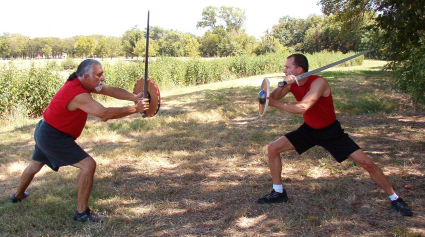
Fourth Guard - Head (capiti)
Fourth guard is held with the sword hilt over the head with the blade pointing rearward, the buckler held forward and the right foot forward. The Fourth guard is another equivalent of the longsword guard Vom Tag. A passing step with either leg will take you out of Fourth Guard and into the Second Guard.
The primary cut from Fourth guard is a true edge vertical cut and a left true edge diagonal cut. As with the First and Third guards, a left Krumphau and a left Zwerchau can also be performed but these cuts are not shown in I.33. With the right leg always forward, the Fourth guard is focused on attacking the adversary's strong side. Both the Closed and Open Stances can be used with the Fourth guard.
4th vs. Half-Shield
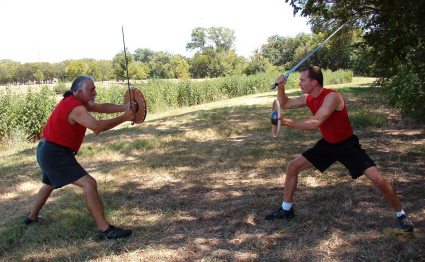
Fifth Guard- Right Side (latere dextro)
In Fifth guard the sword is held with the hilt out from your right side and the blade pointing down with the true edge facing forward. The buckler is held forward and the left leg is forward. Both the Closed Stance and Open Stance can be used. As with the Second guard, having the left leg forward sets the focus of this guard on attacking the adversary's weak side.
The primary attack from Fifth guard described in I.33 is a thrust made by quickly flipping the point of the blade up and then forward. However, both a right Oberhau and a right Unterhau can be made from Fifth Guard.
5th vs. Special Longpoint
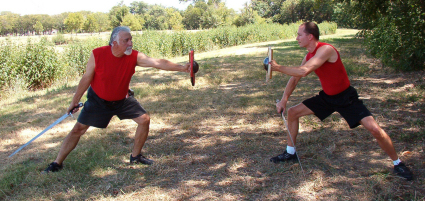
Sixth Guard - Breast (pecton)
In the Sixth Guard the sword is held on the right side pointed at the adversary with the palm turned out and the buckler hand forward. The sword is usually held at the level of the chest but the height of the sword can vary from the level of the waist up to the level of the head. Sixth guard is seen in earlier Byzantine art work (Dawson 2009:81). The images of I.33 and the Byzantine art show both Closed and Open Stances being used with the Sixth guard.
Sixth guard has been misinterpreted as having the sword held with the right hand turned under so that the palm is facing up and the pommel is directly in front of the chest (see Windsor 2008:11). This is a misinterpretation of the drawing of the hand in the images of Sixth guard (see 17r at http://freywild.ch/i33/i33cen.html#33 ). The text of I.33 never describes such a position. Moreover, this position does not make martial sense as a thrust from that position is weak and the sword is not readily available to perform defensive actions, plus one cannot easily transit from that position into the other guards. I interpret the image as having the sword hand turned out, making the guard an equivalent to the longsword guard Ochs.
The primary attack from Sixth guard is the same thrust made from the Fifth guard. The Open Stance offers a lot of advantages in Sixth guard for controlling the distance for a thrust by shifting one's weight between the front and rear leg. From Sixth guard one can also quickly transition into Second guard, Fifth guard, or Fiddlebow.
6th vs. Half-Shield
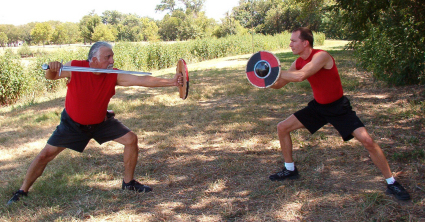
Seventh Guard - Longpoint (langort)
Seventh guard is held with the blade pointing forward and down with the buckler covering the hilt. The thumb is on the flat of the blade and the blade is turned so that the the true edge is facing to the left. This allows the true edge to be quickly turned up during a rising cut, making for a more powerful cut and allowing a quick zuckening if the cut is displaced. Both the Open and Closed stance can be used with the Seventh Guard. The Seventh guard is functionally similar to the longsword guard Alber, so much so that it is broken with a vertical cut identical to how the Alber guard is broken in longsword.
There are two other versions of the Seventh guard; one with the blade pointing straight at the adversary and another with the blade pointing over the adversary's head. Seventh Guard with the blade pointing straight at the adversary is a "common displacement" to the First guard (6V, page 12) but it is not very effective since the one in First Guard can easily bind against it.
7th vs. 2nd
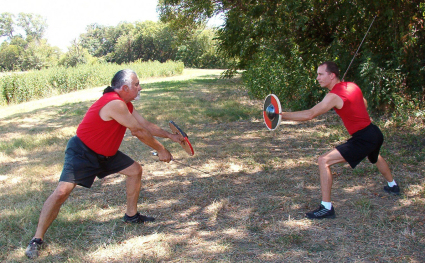
Obsesseo Guards
What makes the sword & buckler system of I.33 highly effective is the Obsesseo guards. The effectiveness of the obsesseo guards lies in their ability to both defend and establish binds as well as attack. Most scholars have interpreted the word "obsesseo" as "displacement" or "counter". However, Jeffery Forgeng (2003:8, 150) noted that the word normally meant "siege" or "blockage". The "blockage" definition actually gives a better indication of the intent of the obsesseo guards. When used in constant motion the Obsesseo guards are highly effective at barricading off the weaker left side while allowing quick attacks. Just as in longsword, by barricading your weak side the adversary is forced to attack your strong side from his weak side. The Obsesseo guards also allow effective binding. It is very clear in I.33 that the author placed a very strong emphasis on audaciously seeking the bind. The core of I.33 is attacking after a Shield-Strike and it is binding that allows the Shield-Strike.
Forcing the adversary to attack your weak side has a major effect upon the body position during binding. Binding on your weak side results in a crossing of your arms. Therefore, when you bind on the weak side you must make sure that your right arm is over your left arm so that after a Shield-Strike with your buckler your sword arm is free to attack. Moreover, when you bind on your weak side, your follow up attacks are being made from your weak side. When you bind on your strong side your arms do not cross, thus after a Shield-Strike your sword arm is always free to attack. Plus, your follow up attacks are from your strong side.
Half-Shield (halpschilt)
Half-Shield is held with the hilt straight out just under one's line of sight with the blade pointing up and slightly forward and the buckler held next to the hilt. Either leg can be forward in either the Closed Stance or Open Stance. Half-Shield is the primary Obsesseo in I.33, as it can be used to counter all of the common guards. As a general rule, when in doubt of what Obsesseo to use, go to Half-Shield.
Brian Hunt (2007) and Keith Myers (2001), like so many other scholars, mistakenly interpreted Half-Shield as being held and used like the longsword guard Pflug. However, from the manner in which Half-Shield is held and used in I.33, it is undoubtedly the equivalent of the Kron guard. This becomes even clearer when the thumb is placed on the flat of the blade, since this results in the guards of the sword projecting out to the sides between 45 and 90 degrees to the front. Having the guards pointing to the side makes them ready to bind against possible vertical cuts and stops a vertical cut from separating the sword and buckler, which I.33 states is a common attack against Half-Shield. With longsword one normally does not stand in Kron due to the vulnerability of the hands, but with the buckler held next to the hilt, the vulnerability of the hands is greatly minimized. The buckler can easily be moved around the hilt to protect the hands from attacks on the right side.
Being a protective form of Kron allows Half-Shield to effectively barricade off vertical cuts while allowing easy binding against both right and left diagonal cuts. Attempts to cut under Half-Shield to the legs leaves one's head vulnerable to attack, something that I.33 stresses. From Half-Shield false edge cuts can be made on the right and true edge cuts can be made on the left. Thrusts can be made by quickly transitioning to Longpoint by lowering the point.
Half-Shield vs. 1st
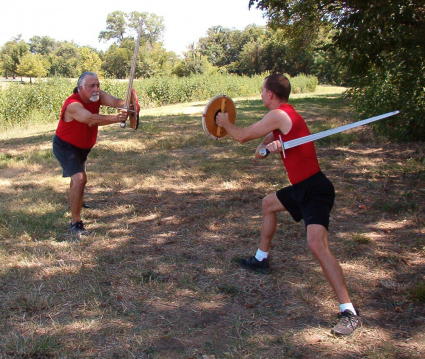
Crook (krucke)
Crook is used to counter the First guard (Under-Arm) and Third guard (Left Shoulder). The hilt is held just under one's line of sight with the blade pointing down roughly 45 degrees to the left. The buckler is held to the front and the blade is held either on the outside or the inside of the left arm. The thumb should be on the lower flat of the blade, leaving the flat ready to ward blows. When the sword is held outside of the left arm the right wrist is over the left wrist and the ricasso is against the left arm. Against Third guard the buckler is held facing to the right side.
Functionally, Crook is the equivalent of the Schrankhut (Barrier) guard in longsword. Since the counter from both First and Third guard is a hard bind on top of the blade, having the blade over the right arm allows one to be much stronger in the bind since the ricasso is supported by the left arm. As with the Barrier guard in Longsword, Crook can be raised up and used as a hanging guard.
If the sword is held outside of the left arm, a strong right false edge diagonal cut can be made by simply flipping the sword over to the right. If the sword is held inside of the left arm then a true edge left Zorn can be made by flipping the sword over on the left.
Krucke vs. 1st
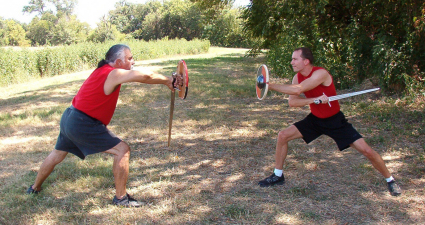
Cover (schutzen)
Cover refers to both a displacement and a position used to counter the Second Guard. As a position, Cover is held on the left side with the right wrist over the left arm just behind the buckler with the arms extended forward. Due to the limited space within the I.33 manual, Cover was drawn with the sword pointed over the priest's head (see top image on 9r, page 17). However, in actual use, the sword should be pointed at either the adversary's face or chest. This leaves the buckler on the inside of the blade. Cover may be held with the true edge down or with the true edge up with the right thumb on the flat of the blade.
When Cover is held with the false edge up and the thumb on the flat, it is easy to see that Cover is the equivalent of a left Pflug. As with Pflug, Cover should be used with constant motion to barricade off the your weak left side. Interestingly, Second Guard breaks Cover with a false edge cut in the exact same manner as Pflug is broken in longsword with a Schiller (see bottom image on 9r, page 17). The natural attack from Cover is a thrust. A true edge diagonal cut or a true edge horizontal cut can also be made on the left by quickly transitioning to Third Guard.
Cover vs. 2nd
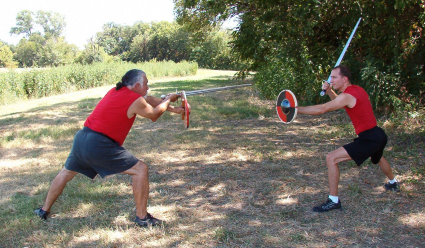
Priest's Special Longpoint
The Priest's Special Longpoint is held with the hilt in front of the right hip and the blade pointing down to the left at about a 45 degree angle. The buckler is held in front of the left chest. Either leg can be forward but in most cases the right leg is forward. Both the Closed and Open Stances can be used regardless of which leg is forward.
The Priest's Special Longpoint is basically a reverse equivalent to the Iron Door guard in longsword. The weak side is well guarded with the blade covering the lower left opening and the buckler covering the upper left opening, enticing the adversary to attack the strong side. The blade can be easily moved over to intercept low attacks on the right or flipped up to intercept high attacks on the right.
The natural attacks from the Priest's Special Longpoint is a thrust and a false edge cut on the right or a true edge cut on the left.
Priest's Special Longpoint vs. 5th
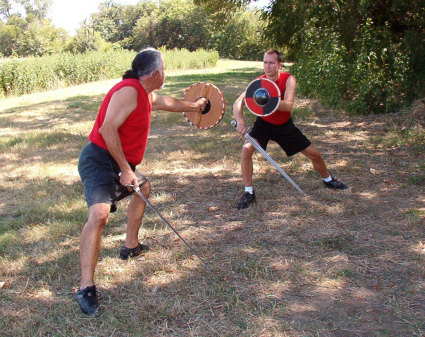
Special Ward at the Right Shoulder
The Special Ward at the Right Shoulder (aka Special Second Guard) is similar to the Second guard, except the hilt is held slightly lower with the blade pointing straight up. This guard is shown only with the feet in the Closed stance, but the Open stance can also be used.
I.33 does not show an actual attack cut being performed from this guard. The sword is shown only as being thrown out to bind against the Crook Obsesseo guard in the same manner as is done from the First guard.
Special Ward at Right Shoulder vs. Krucke
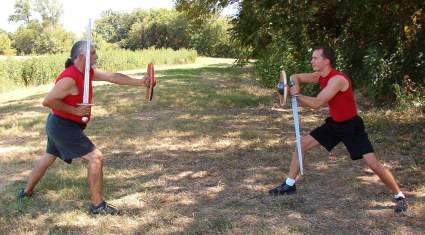
Fiddlebow
Fiddlebow is held with the blade behind the buckler at roughly a 45 degree angle with the point up and slightly forward over the left arm. When Fiddlebow is used with constant motion the fighter looks like he is playing a fiddle. In I.33 Fiddlebow is used to bind against an Oberhau strike with the blade intercepting the oncoming blade and, like a reverse hanging, guides the other blade to the buckler from which one can overbind on the right to Shield-Strike and counter attack.
A major misunderstanding of Fiddlebow is how the sword is held in relationship to the left arm. Some I.33 scholars (Myers 2001, Hunt 2007, Windsor 2008) interpreted Fiddlebow as having the sword resting across the left arm. However, I.33 never shows the blade on the left arm. Moreover, this is martially unsound for two reasons. First, anytime a weapon is at rest it must be picked up before it can be put into action. Second, and more importantly, laying a sharp weapon across one's arm, especially the sharper weak of the blade, puts one at risk of an accidental cut. For both of these reasons, laying a sharp weapon across one's left arm is no different than laying a sharp weapon upon one's shoulder.
Fiddlebow is listed among the Obesseo guards since it is useful for binding. However, I.33 also notes that Fiddlebow is a commonly used guard, which suggest that it was also used by the less skilled fighters.
Fiddlebow vs. 2nd
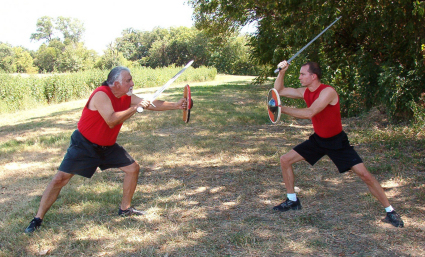
References
Clements, John. Volta, Key, and Scale. 2010. http://www.thearma.org/VoltaKeyandScale.htm
Dawson, Timothy. The Walpurgis Fechtbuch: An Inheritance of Constantinople? Arms & Armour, Volume 6, Number 1, 2009, pages 79-92. http://www.levantia.com.au/military/AAA_Dawson.pdf
Forgeng, Jeffery L. The Medieval Art of Swordsmanship: A Facsimile & Translation of the World's Oldest Personal Combat Treatise. Chivalry Bookshelf, 2003. Highland, Texas.
Forgeng, Jeffery L. The Art of Combat: A German Martial Arts Treatise of 1570 by Joachim Meyer. Greenhill Books, 2006. London.
Hunt, Brian. A Comparative Pictorial Study of the Wards and Techniques of the late 13th century Sword & Buckler Manuscript I.33, or Tower Fechtbuch. 2007. http://www.thearma.org/Manuals/I33-guards.html
Leoni, Tommaso and Steven Reich. Illustrated Guide to the Bolognese Guards for Single-handed Sword. http://www.salvatorfabris.org/BologneseGuards.shtml
Myers, Keith P. Lignitzer's Sword & Buckler Teachings. 2001. http://www.thearma.org/essays/LeignitzerSandB.htm
Freywild. Translation of I.33.
http://freywild.ch/i33/i33en.html
Windsor, Guy. Taking the Initiative: The Technical and Tactical Structure
of I.33. 2008.
http://www.swordschool.com/assets/files/pdf/133article080424.pdf
|
|
|||
|
|
|||
|
|||